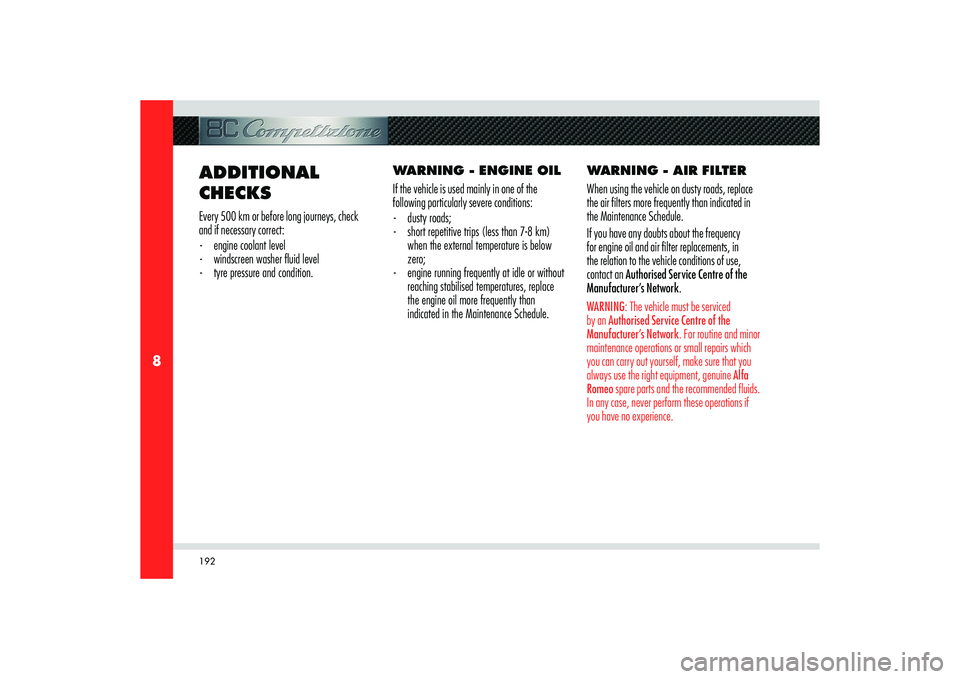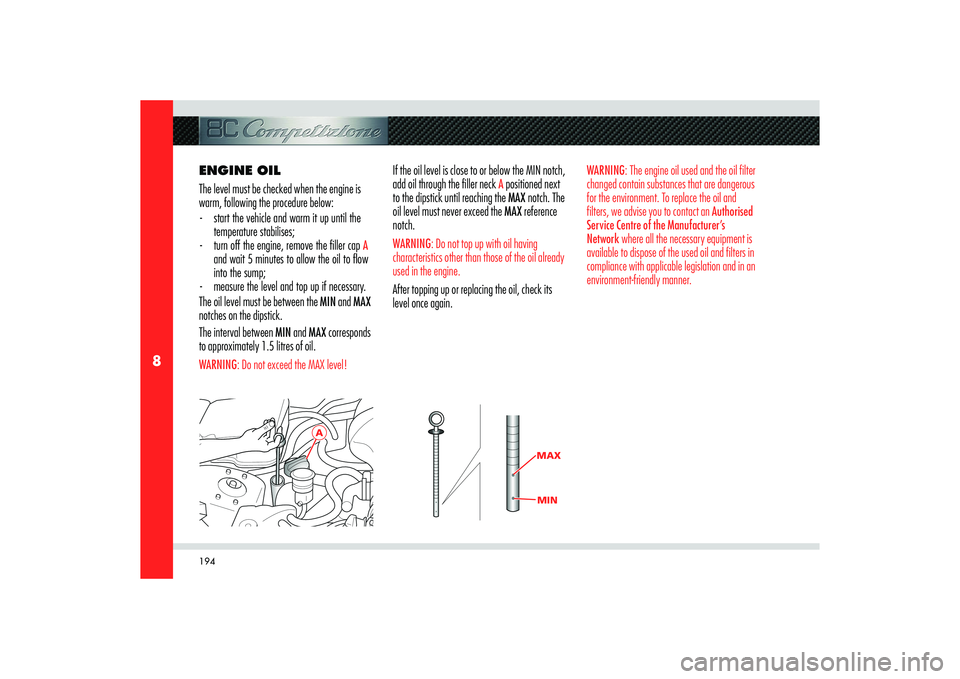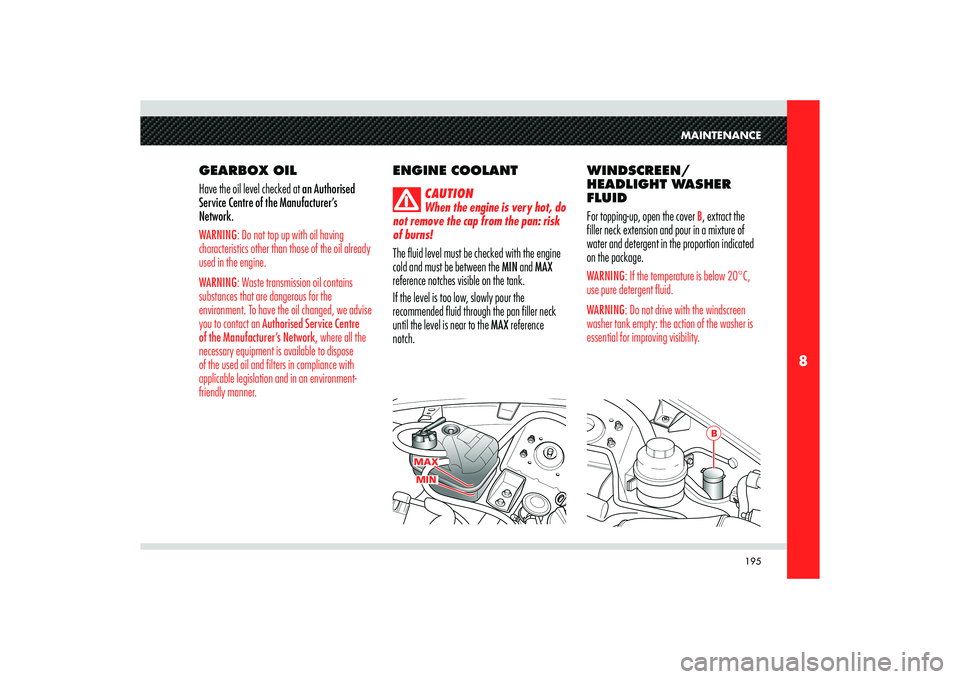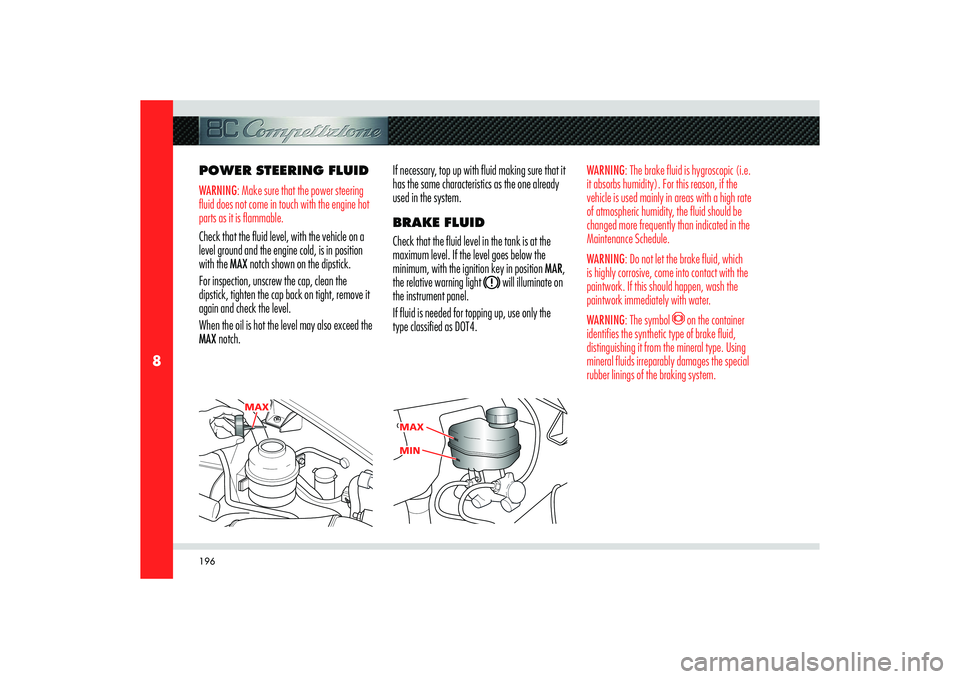warning Alfa Romeo 8C 2008 Owner handbook (in English)
[x] Cancel search | Manufacturer: ALFA ROMEO, Model Year: 2008, Model line: 8C, Model: Alfa Romeo 8C 2008Pages: 223, PDF Size: 14.35 MB
Page 194 of 223

192
8
ADDITIONAL
CHECKSEvery 500 km or before long journeys, check
and if necessary correct:
- engine coolant level
- windscreen washer fl uid level
- tyre pressure and condition.WARNING - ENGINE OIL
If the vehicle is used mainly in one of the
following particularly severe conditions:
- dusty roads;
- short repetitive trips (less than 7-8 km)
when the external temperature is below
zero;
- engine running frequently at idle or without
reaching stabilised temperatures, replace
the engine oil more frequently than
indicated in the Maintenance Schedule. WARNING - AIR FILTER
When using the vehicle on dusty roads, replace
the air filters more frequently than indicated in
the Maintenance Schedule.
If you have any doubts about the frequency
for engine oil and air filter replacements, in
the relation to the vehicle conditions of use,
contact an Authorised Service Centre of the
Manufacturer’s Network.
WARNING: The vehicle must be serviced
by an Authorised Service Centre of the
Manufacturer’s Network. For routine and minor
maintenance operations or small repairs which
you can carry out yourself, make sure that you
always use the right equipment, genuine Alfa
Romeo spare parts and the recommended fluids.
In any case, never perform these operations if
you have no experience.
Page 196 of 223

194
8
A
MAXMIN
ENGINE OIL
The level must be checked when the engine is
warm, following the procedure below:
- start the vehicle and warm it up until the
temperature stabilises;
- turn off the engine, remove the fi ller cap
A
and wait 5 minutes to allow the oil to fl ow
into the sump;
- measure the level and top up if necessary.
The oil level must be between the MIN and MAX
notches on the dipstick.
The interval between MIN and MAX corresponds
to approximately 1.5 litres of oil.
WARNING: Do not exceed the MAX level!
If the oil level is close to or below the MIN notch,
add oil through the filler neck
A positioned next
to the dipstick until reaching the MAX notch. The
oil level must never exceed the MAX reference
notch.
WARNING: Do not top up with oil having
characteristics other than those of the oil already
used in the engine.After topping up or replacing the oil, check its
level once again.
WARNING: The engine oil used and the oil filter
changed contain substances that are dangerous
for the environment. To replace the oil and
filters, we advise you to contact an Authorised
Service Centre of the Manufacturer’s
Network where all the necessary equipment is
available to dispose of the used oil and filters in
compliance with applicable legislation and in an
environment-friendly manner.
Page 197 of 223

195
8
MAXMIN
B
MAINTENANCE
GEARBOX OIL
Have the oil level checked at an Authorised
Service Centre of the Manufacturer’s
Network.WARNING: Do not top up with oil having
characteristics other than those of the oil already
used in the engine.
WARNING: Waste transmission oil contains
substances that are dangerous for the
environment. To have the oil changed, we advise
you to contact an Authorised Service Centre
of the Manufacturer’s Network, where all the
necessary equipment is available to dispose
of the used oil and filters in compliance with
applicable legislation and in an environment-
friendly manner.
ENGINE COOLANT
CAUTION
When the engine is very hot, do
not remove the cap from the pan: risk
of burns!
The fluid level must be checked with the engine
cold and must be between the MIN and MAX
reference notches visible on the tank.
If the level is too low, slowly pour the
recommended fluid through the pan filler neck
until the level is near to the MAX reference
notch.WINDSCREEN/
HEADLIGHT WASHER
FLUID
For topping-up, open the cover
B, extract the
filler neck extension and pour in a mixture of
water and detergent in the proportion indicated
on the package.
WARNING: If the temperature is below 20°C,
use pure detergent fluid.
WARNING: Do not drive with the windscreen
washer tank empty: the action of the washer is
essential for improving visibility.
Page 198 of 223

196
8
MAX
MA
X MAX
MIN MIN
POWER STEERING FLUIDWARNING: Make sure that the power steering
fluid does not come in touch with the engine hot
parts as it is flammable.Check that the fluid level, with the vehicle on a
level ground and the engine cold, is in position
with the MAX notch shown on the dipstick.
For inspection, unscrew the cap, clean the
dipstick, tighten the cap back on tight, remove it
again and check the level.
When the oil is hot the level may also exceed the
MAX notch.If necessary, top up with fluid making sure that it
has the same characteristics as the one already
used in the system.
BRAKE FLUID
Check that the fluid level in the tank is at the
maximum level. If the level goes below the
minimum, with the ignition key in position MAR,
the relative warning light
will illuminate on
the instrument panel.
If fluid is needed for topping up, use only the
type classified as DOT4.
WARNING: The brake fluid is hygroscopic (i.e.
it absorbs humidity). For this reason, if the
vehicle is used mainly in areas with a high rate
of atmospheric humidity, the fluid should be
changed more frequently than indicated in the
Maintenance Schedule.
WARNING: Do not let the brake fluid, which
is highly corrosive, come into contact with the
paintwork. If this should happen, wash the
paintwork immediately with water.
WARNING: The symbol
on the container
identifies the synthetic type of brake fluid,
distinguishing it from the mineral type. Using
mineral fluids irreparably damages the special
rubber linings of the braking system.
Page 199 of 223

197
8
MAINTENANCE
AIR FILTERHave the air filter replaced at an Authorised
Service Centre of the Manufacturer’s
Network.
ANTI-DUST/ANTI-
POLLEN FILTERThis filter performs mechanic/electrostatic air
filtering, provided that windows and doors are
fully closed.
Have the anti-pollen/dust filter replaced at least
once a year, at an Authorised Service Centre of
the Manufacturer’s Network preferably at the
beginning of the warm season.
If the vehicle is mainly used in the city traffic,
on highways or dusty roads, we recommend
that you replace the filters more frequently than
prescribed in the Maintenance Schedule.
WARNING: Failure to replace the filter may
considerably reduce the air conditioning and
heating system efficiency.
CAUTION
We advise you to have the
anti-pollen/dust filter replaced at
an Authorised Service Centre of the
Manufacturer’s Network.
Page 200 of 223

198
8
A
B
C
BATTERYThe battery is of the “low maintenance” type,
and is located on the right side of the luggage
compartment
To access the battery lift the shelf and
A and the
box cover
B releasing the hooks.
C.
With the vehicle standing on a flat surface, the
battery fluid level (electrolyte) must be between
the MIN and MAX reference notches shown on
the battery.
If the level is lower than the MIN reference
notch, contact an Authorised Service Centre
of the Manufacturer’s Network to have it
checked.To recharge the battery, see the section “In an
emergency”.
CAUTION
The fluid contained in the
battery is poisonous and corrosive.
Avoid contact with the skin and eyes.
Do not approach the battery with open
flames or possible sources of sparks:
risk of explosion and fire!
Batteries contain substances that are very
harmful for the environment. We advise you
to have the battery replaced at an Authorised
Service Centre of the Manufacturer’s
Network, where all the necessary equipment
is available to dispose of the used parts in compliance with applicable legislation and in an
environment-friendly manner.
WARNING: Incorrect assembly of electrical and
electronic accessories can cause serious damage
to the vehicle.USEFUL HINTS FOR
EXTENDING THE LIFE OF
THE BATTERY
When parking the vehicle, make sure that the
doors, luggage and engine compartment lids
are properly closed. All interior lights should be
off. When the engine is off, do not keep the
connected devices switched on for a long time
(for example the radio, the hazard warning
lights, the fan, etc.).
Page 201 of 223

199
8
MAINTENANCE
WARNING: If the battery charge remains
below 50% for a long period of time, it will be
damaged due to sulphating: this will reduce its
performance and starting power and the battery
will be more subject to freezing (this can happen
even at -10°C).We recommend that you have the battery charge
condition checked, preferably at the beginning of
the cold season, to prevent the electrolyte from
freezing.
This check should be performed more frequently
if the vehicle is used mainly for short trips or if it
is equipped with power absorbing devices that
remain permanently on even if when the ignition
key is removed. This applies above all if these
devices have been fitted “after market”.
If the vehicle is not used for long periods of time,
please refer to chapter “If the vehicle is laid up
for long periods”, in this section.WARNING: If additional systems have to be
fitted in the vehicle, there is the risk of creating
dangerous branches on the electric wiring, in
particular if the safety devices are involved.
ELECTRONIC
CONTROL UNITSNo special precautions are required for the
normal use of the vehicle.
In the event of repairs to the electrical system
or in an emergency starting, the following
instructions must be strictly followed:
- Never disconnect the battery from the
electrical system when the engine is
running.
- Disconnect the battery from the electrical
system when recharging it (see page 168
“If the battery is fl at”). WARNING: When the battery is disconnected,
you must first detach the negative pole terminal
(–) and then the positive pole one (+).
WARNING: The battery is secured inside the
vehicle by means of a metal box, therefore, be
extremely careful not to let the battery charger
clips come into contact with it.WARNING: When the battery is reconnected,
you must first attach the positive pole (+),
remembering to cover it with the cap provided,
and then the negative one (–).
- Never perform the emergency starting
procedure using a battery charger: always
use an auxiliary battery.
- Take special care when connecting the
battery to the electrical system, checking
both that polarity is correct and that the
connection is properly working.
- Do not connect or disconnect the terminals
of the ECUs when the ignition key is at
MAR.
- Do not check the electric polarities through
sparking.
- Disconnect the ECUs in the event of
electrical welding on the vehicle body.
Remove them if the temperature is
over 80°C (special interventions on the
bodywork, etc.).
Page 202 of 223

200
8
WARNING: Incorrect installation or modifications
to the audio and alarm systems may interfere
with the proper operation of the Electronic
Control Units.
WARNING: Changes or repairs to the electrical
system carried out in an incorrect manner
or without taking into account the technical
specifications of the system may cause operating
malfunctions with the risk of fire.
WARNING: If you need to wash the engine
compartment, do not direct the jet of water for
too long directly on the engine compartment
ECU.
SPARK PLUGSIt is essential that the spark plugs are sound and
clean to help ensure engine performance and to
keep polluting emissions to a minimum level.WARNING: The spark plugs must be changed
at the intervals specified in the Maintenance
Schedule. Only use the recommended spark
plugs: faults may arise if the heat rating is
unsuitable, or if the specified duration is not
guaranteed.
WHEELS AND
TYRESTo obtain the best performances and
the longest tyre life, comply with the
following precautions during the first
500 Km:
- do not drive at maximum
permitted speed
- drive on curves at low speed
- avoid sudden steering
- avoid sudden braking
- avoid sudden accelerations
- do not drive long at high speeds
for too long.
Page 203 of 223

201
8
MAINTENANCE
HOW TO USE THE TYRESWARNING: The tyres must be constantly kept in
good conditions to ensure safe driving.Tyre inflation pressure must correspond to the
prescribed values and should be checked only
when the tyres are cold: the pressure increases
as the tyre temperature progressively increases.
Never reduce the pressure if tyres are warm.
Insufficient tyre inflating pressure can cause tyre
overheating and possible internal damages,
which may even lead to the tyre destruction.
CAUTION
Check the tyre inflating
pressure at least every two weeks and
before long trips.
Impacts with kerbs, holes, and obstacles in the
road, as well as prolonged trips on rough roads
can cause tyre damage which may not be visible
to the naked eye.
Check your tyres regularly for any signs of
damage (e.g. scratches, cuts, cracks, bulges,
etc.).
If sharp objects penetrate the tyres, they can
cause damage which is only visible when the tyre
is removed.
In any case, any possible damage must be
inspected by an experienced tyre fitter, as it may
seriously reduce the tyre life.
Remember that tyres deteriorate with time, even
if used little or not at all.
Cracks in the tyre tread and sides, alongside
possible bulging, are a sign of deterioration.
CAUTION
Have the old tyres inspected
by an experienced tyre fitter, to make
sure they can still be used safely. If the
same tyre has been on your vehicle for
4 or 5 years, have it inspected anyway
by an experienced tyre fitter.
CAUTION
Never fit tyres of uncertain
origin.
CAUTION
“Directional” tyres have an
arrow on their side showing the
rolling direction. To maintain optimal
performance when replacing a tyre,
make sure that the rolling direction
corresponds to the one marked by the
arrow.
Page 205 of 223

203
8
B
A
C
MAINTENANCE
SPRAY NOZZLES
If the jet does not work, first check that there
is fluid in the pan (see “Level checks” in this
section) then check that the nozzles are not
clogged.REPLACING THE WIPER
BLADES
1) Release the blade
A by lifting the catch
B.
2) Slide the blade
A to the right to remove it
from the arm. C.
3) Fit the new blade working in reverse order.
WARNING: When replacing the blade, be careful
not to damage the bodywork or the blade itself.
AIR
CONDITIONING/
HEATING SYSTEMDuring the winter, the air conditioning system
should be operated at least once a month for
about 10 minutes.
Before the summer season, have the system
efficiency checked at an Authorised Service
Centre of the Manufacturer’s Network. WARNING: The system uses R134a type
coolant that, in the event of accidental leakage,
is not harmful for the environment. Under no
circumstances should you use R12 fluid that, in
addition to being incompatible with the system
components, contains chloro-fluoro-carbons
(CFCs).